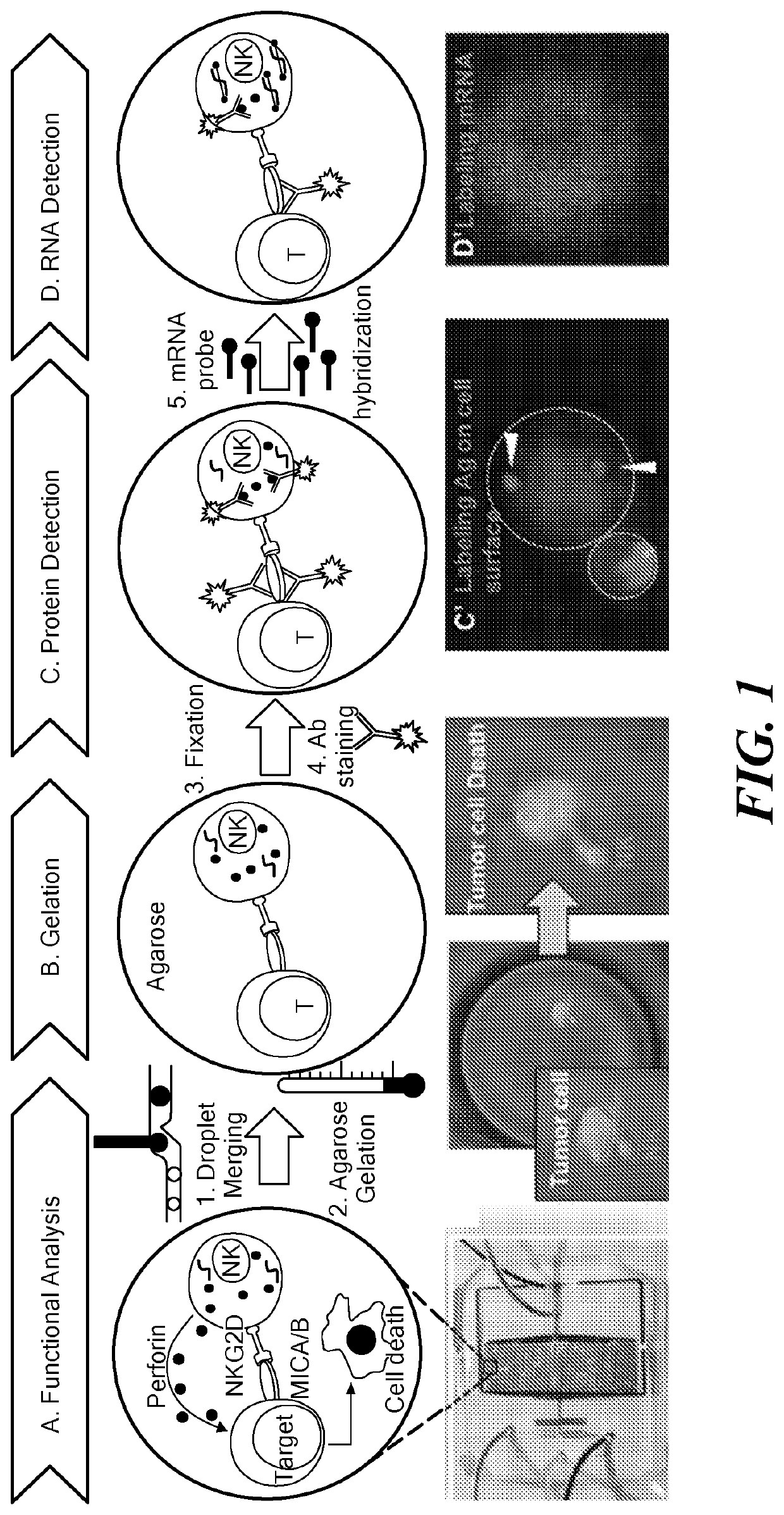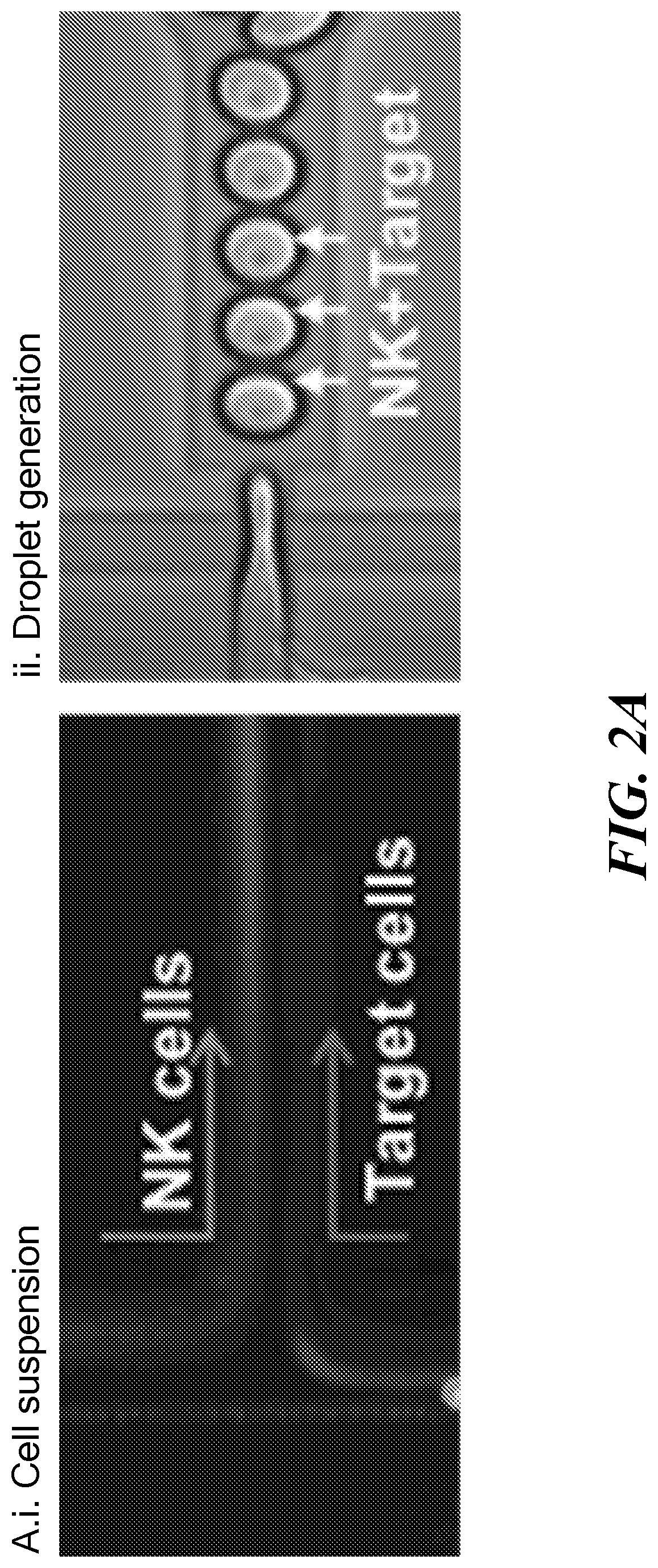Single cell fluorescence in situ hybridization in microfluidic droplets
a technology microfluidic droplets, which is applied in the field of single cell fluorescence in situ hybridization in microfluidic droplets, can solve the problems of inability to retain intracellular spatial resolution of transcripts, few methods available that allow dynamic investigation of immune cell interactions, and take 2-3 days to complete, so as to reduce the overall cost of the procedure, reduce the duration of the assay, and facilitate the effect of mixing reaction kinetics
- Summary
- Abstract
- Description
- Claims
- Application Information
AI Technical Summary
Benefits of technology
Problems solved by technology
Method used
Image
Examples
example 1
dic Device Fabrication
[0092]The microfluidic devices were fabricated by standard soft-lithography protocols. The device design was formulated using CAD (CAD / Art Services, Bandon, Oreg.) and printed on a transparency photomask (Fine Line Imaging, Colorado Springs, Colo.). The design was transferred to clean silicon wafers via UV photolithography utilizing a negative photo resist SU-8 2100 (MicroChem, Newton, Mass.), which was spin-coated on the wafers to obtain a layer of 150 μm height. The wafers served as master templates for elastomeric device fabrication. The prepolymer poly(dimethylsiloxane) (PDMS) (Sylgard 184, Dow Corning, Midland, Mich.) was mixed with the silicone elastomer curing agent at 10:1 ratio (w / w), dispensed over the wafer, degassed and cured for 12 hours at 65° C. The PDMS layer containing the design network was then peeled from the wafer and separated into individual devices. Microscope slides were subjected to plasma oxidation for 30-60 sec and bonded with the PD...
example 2
of Discrete Microscale Agarose Matrix
[0094]Cultured cells were purchased from commercially available sources (e.g., American Type Culture Collection (ATCC, Manassas, Va.)) and maintained in RPMI-1640 medium supplemented with 10% fetal bovine serum and 1% Antibiotic-Antimycotic solution (Corning Cellgro, Manassas, Va.). All cells were grown at 37° C. under 5% CO2 in a humidified atmosphere. Cells were routinely passaged every three days and harvested at a density of 1×106 viable cells / mL. A 1.8% ultra-low temperature gelling agarose solution was merged with the formed droplets and subsequently arrested in the docking array. Cooling of the array resulted in gelation of agarose (FIG. 2C). The agarose droplets remained stable in the array for days under perfusion.
example 3
nce in Situ Hybridization in Microdroplets
[0095]Detection of ABCB1 mRNA in droplet-encapsulated live MCF-7 cells was performed using SmartFlare nanoprobes (EMD Millipore, Billerica, Mass.). Cy5-conjugated ABCB1 mRNA (#SF-2394, Millipore) stock solution was diluted as per the manufacturer's instructions. The final ratio of cells to the diluted probe was maintained at 1×106 cells: 100 μL. The probes and cells were incubated through separate inlets and maintained in the dark for 24 h. The cells were periodically imaged using a Cy5 filter (FIG. 2D).
PUM
| Property | Measurement | Unit |
|---|---|---|
| diameter | aaaaa | aaaaa |
| temperature | aaaaa | aaaaa |
| temperature | aaaaa | aaaaa |
Abstract
Description
Claims
Application Information
 Login to View More
Login to View More - R&D
- Intellectual Property
- Life Sciences
- Materials
- Tech Scout
- Unparalleled Data Quality
- Higher Quality Content
- 60% Fewer Hallucinations
Browse by: Latest US Patents, China's latest patents, Technical Efficacy Thesaurus, Application Domain, Technology Topic, Popular Technical Reports.
© 2025 PatSnap. All rights reserved.Legal|Privacy policy|Modern Slavery Act Transparency Statement|Sitemap|About US| Contact US: help@patsnap.com



